Form 1 Grant Application Instrument and Instruction
Head Start Program Grant Application
Draft Combined Head Start Grant Application Instructions with Guidance April 2025 _41125
Head Start Grant Application
OMB: 0970-0207
Head Start
Grant Application
PAPERWORK
REDUCTION ACT OF 1995 (Pub. L. 104-13) STATEMENT OF PUBLIC BURDEN:
The purpose of this information collection is for eligible
entities to apply for Head Start funding. Public reporting burden for
this collection of information is estimated to average 20 hours per
respondent, including the time for reviewing instructions, gathering
and maintaining the data needed, and reviewing the collection of
information. This collection of information is required to receive
funding under the Head Start Act (42 USC 9801 et seq.). An
agency may not conduct or sponsor, and a person is not required to
respond to, a collection of information subject to the requirements
of the Paperwork Reduction Act of 1995, unless it displays a
currently valid OMB control number.
OMB
Control No: 0970-0207
Expiration date: xx/xx/xx
Types of Applications Available to Grantees
Type |
Description of Request |
Supplement - COLA and Quality Improvement* |
Request for Cost of Living Adjustment (COLA) and Quality Improvement Funding |
Change in Scope |
Conversion |
Enrollment reduction |
|
Add or remove program option |
|
Other programmatic change |
|
Locally Designed Option (LDO) |
|
Request to Consolidate Grants |
|
Supplement* |
Request for additional financial support |
Supplement - COLA* |
Request for Cost of Living Adjustment (COLA) |
Budget Revision* |
Changes in the line item budget |
Nonfederal share waiver requests |
|
Carryover Request - Reprogram* |
Request prior approval for carryover of unobligated funds |
Low Cost Extension |
Low Cost Extensions (LCE) are requested to complete activities of the grant for a set period of time after the final year of the project period, and may be part of closeout activities. |
Grantee Change |
Use this amendment type for grantee name and other changes. Grantee changes can also be made on the Grantee Change tab within existing application types. |
Supplement - Facilities 1303 |
Use this amendment when requesting supplemental funds for the purchase, construction, or major renovation of real property that meets the requirements of 45 C.F.R. Part 1303. |
Revision – Facilities 1303 |
Use this amendment when requesting prior approval to use Head Start funds for the purchase, construction, or major renovation of real property that meets the requirements of 45 C.F.R. Part 1303. This includes fulfilling requirements of restricted funds awarded for real property (i.e. startup) pending submission and approval of a complete 1303 application, for budget revisions, including requests to encumber (financing arrangements, including a finance lease (formerly called capital lease)) real property using Head Start funds. |
Carryover - Facilities 1303 |
Use this amendment when requesting to use an unobligated balance for the purchase, construction, or major renovation of real property that meets the requirements of 45 C.F.R. Part 1303. |
Award – [one-time approp name] |
Application for other one-time appropriation that is not COLA or QI (e.g., funding to increase program hours). |
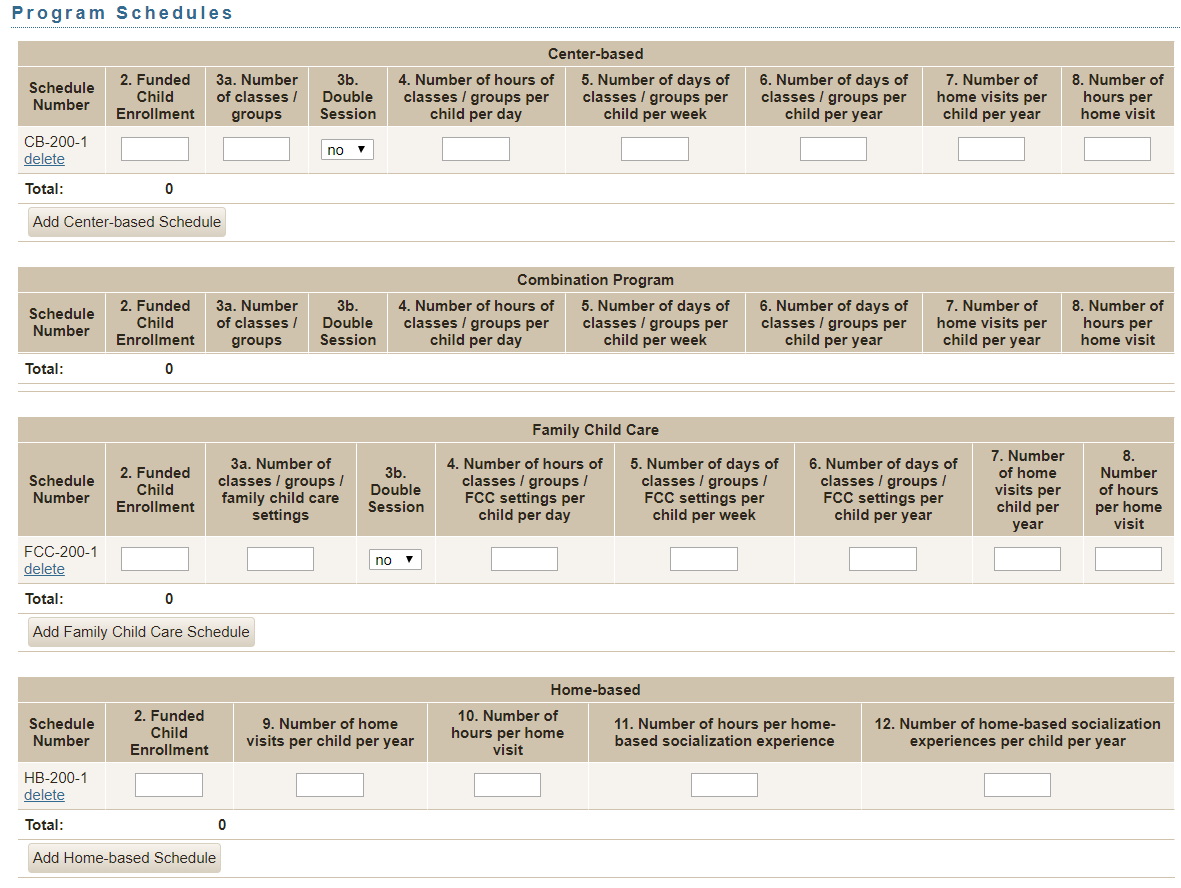
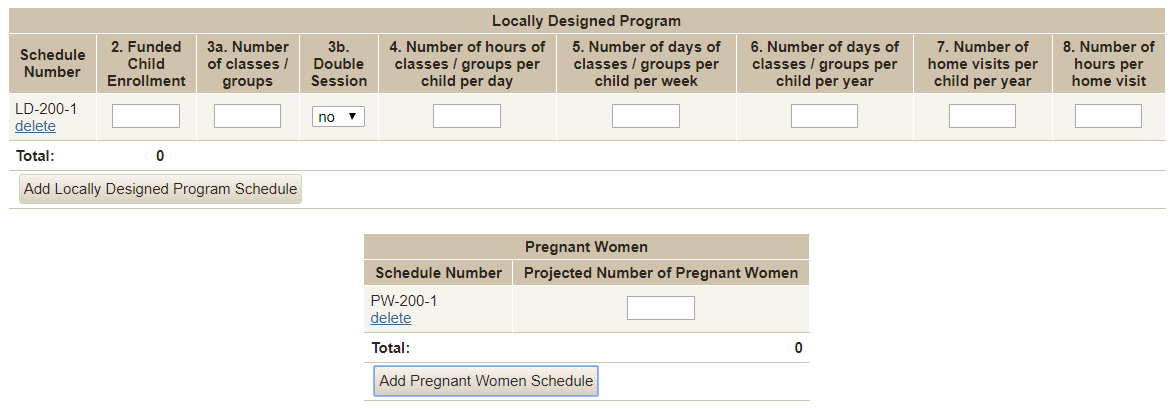
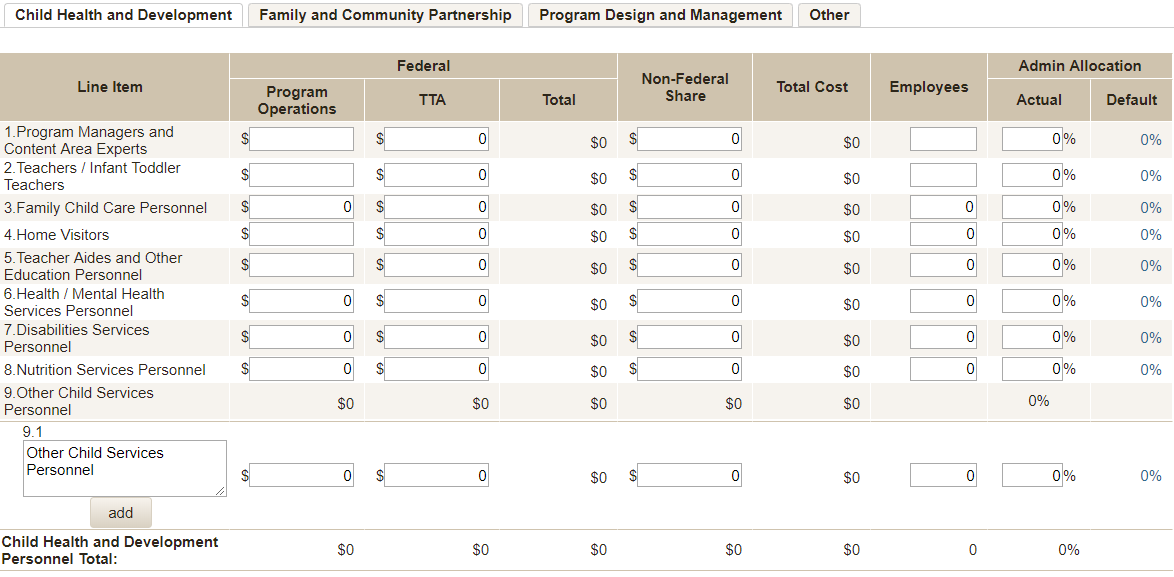

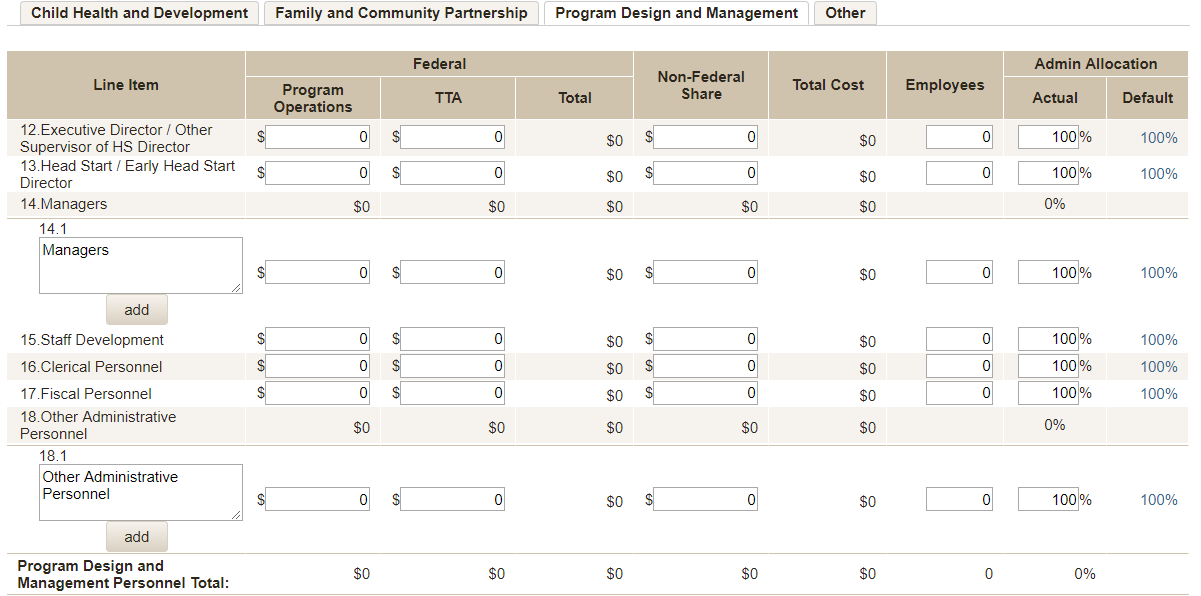

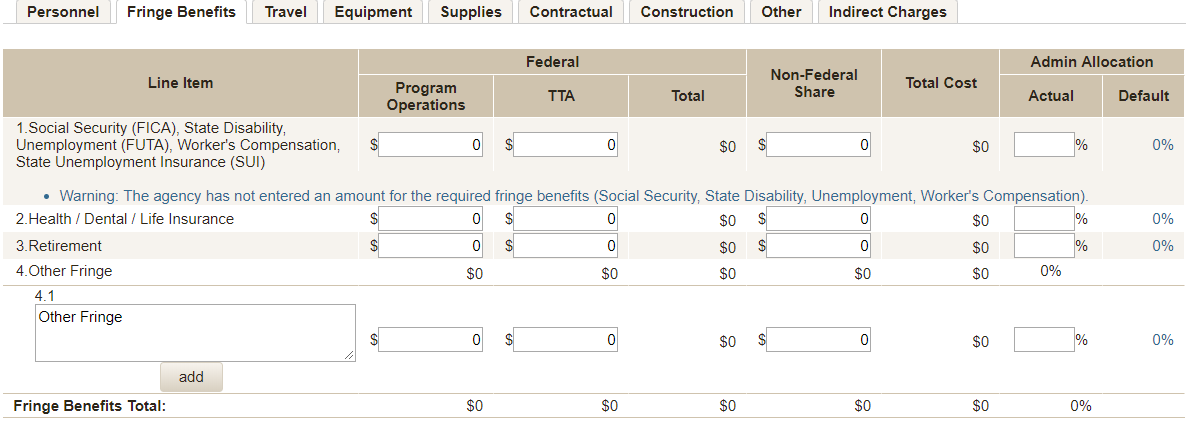



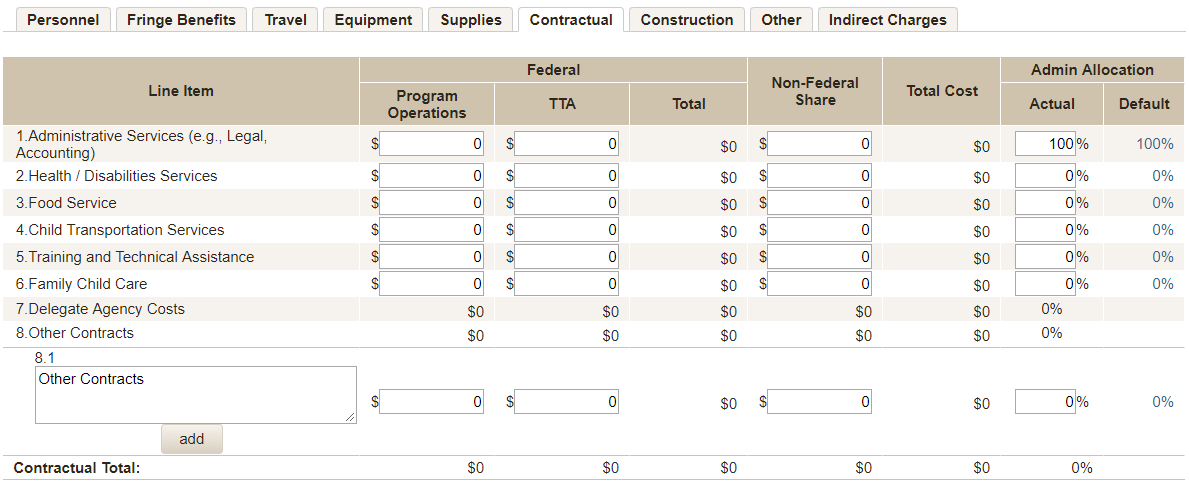
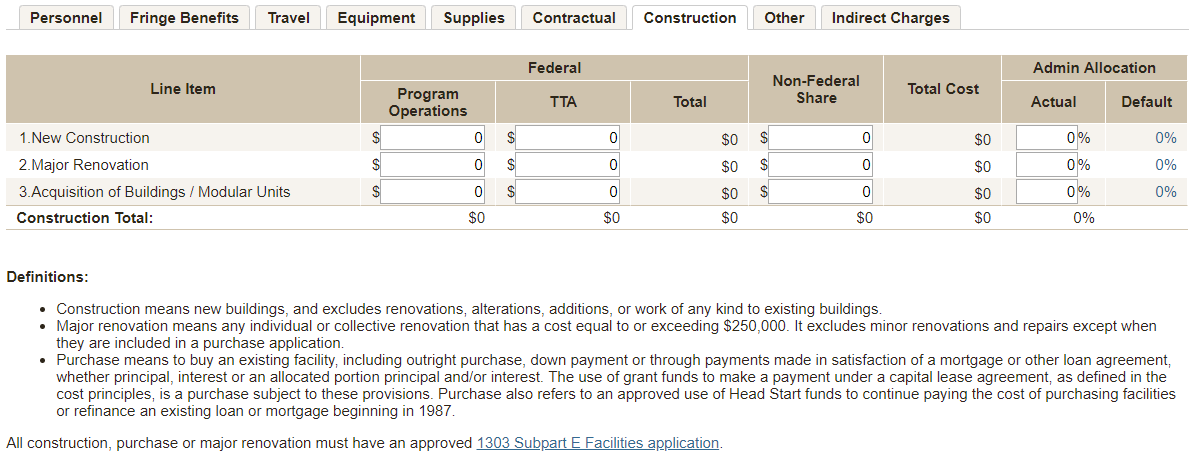
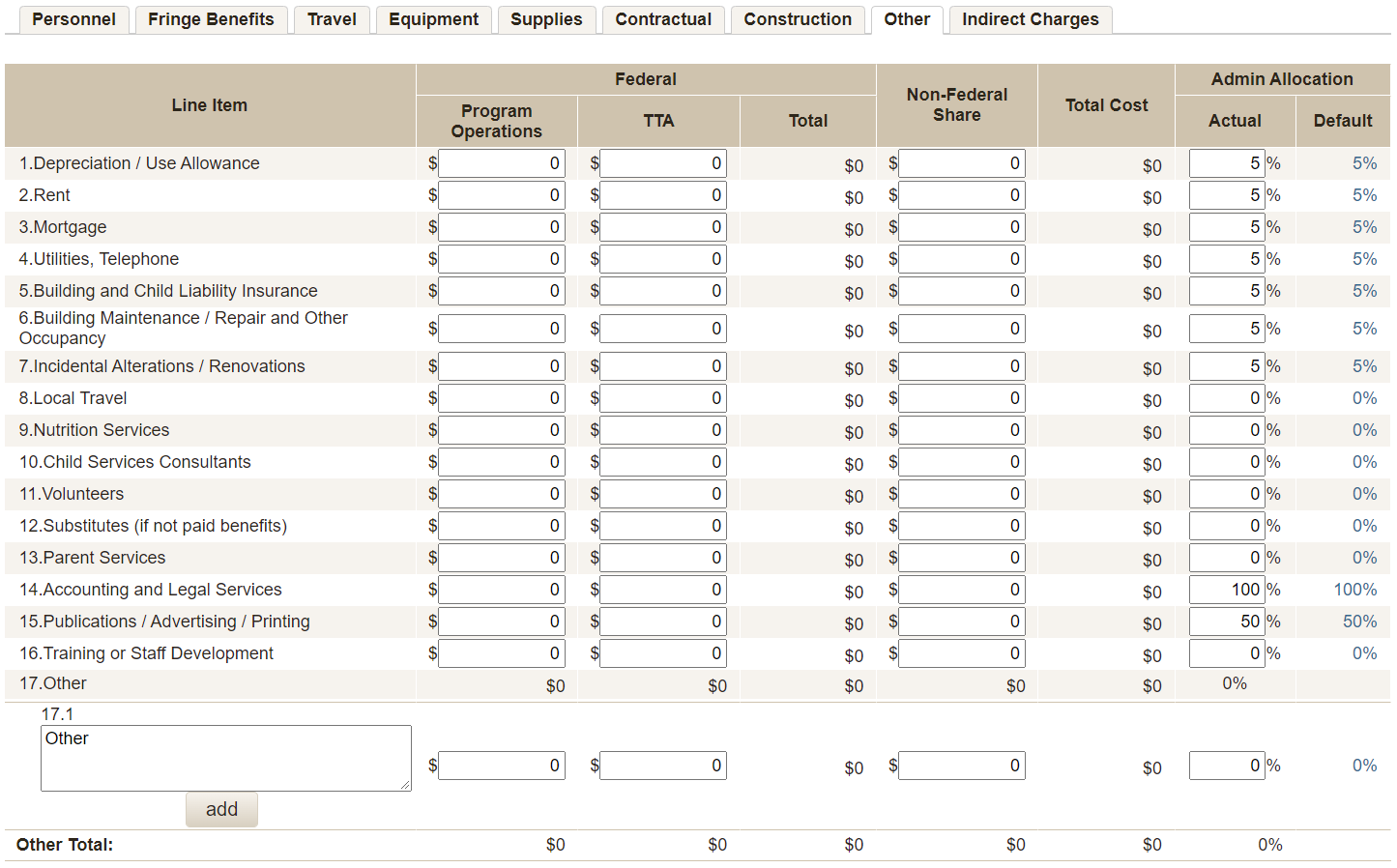

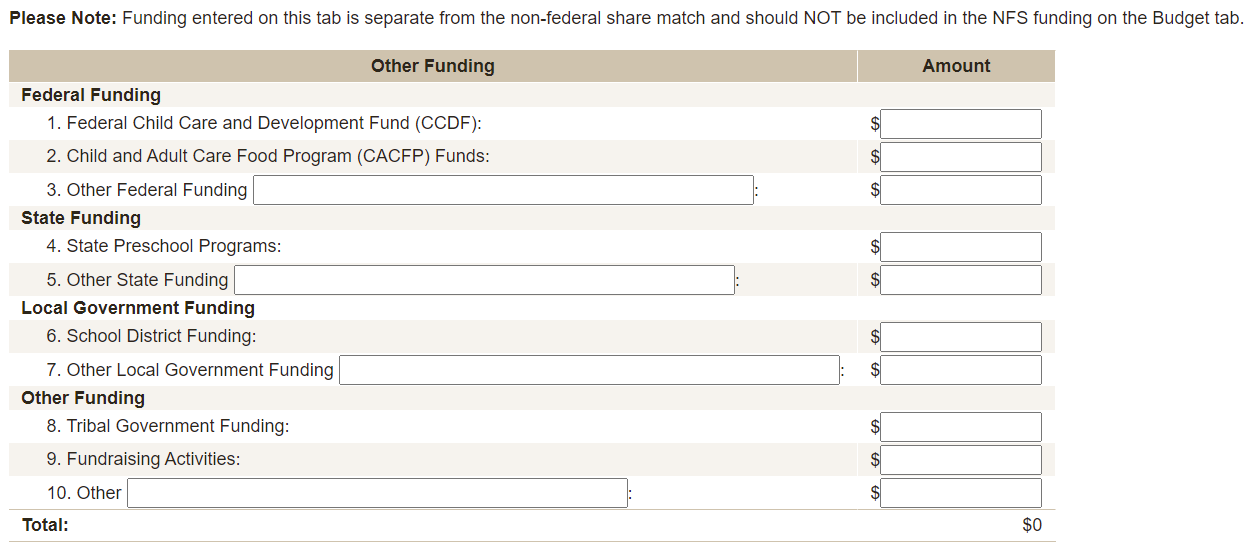
SF-424A

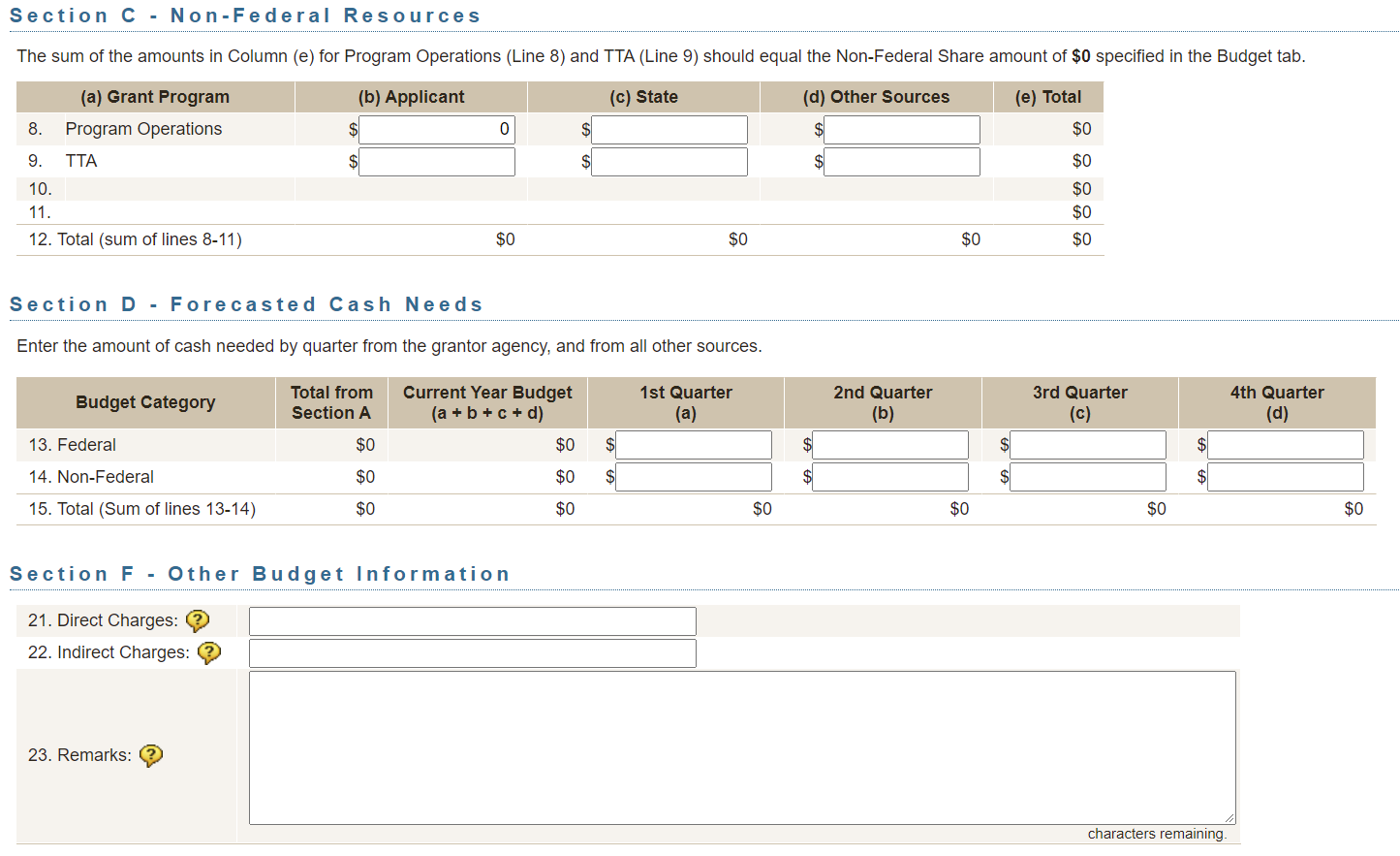
SF-424A
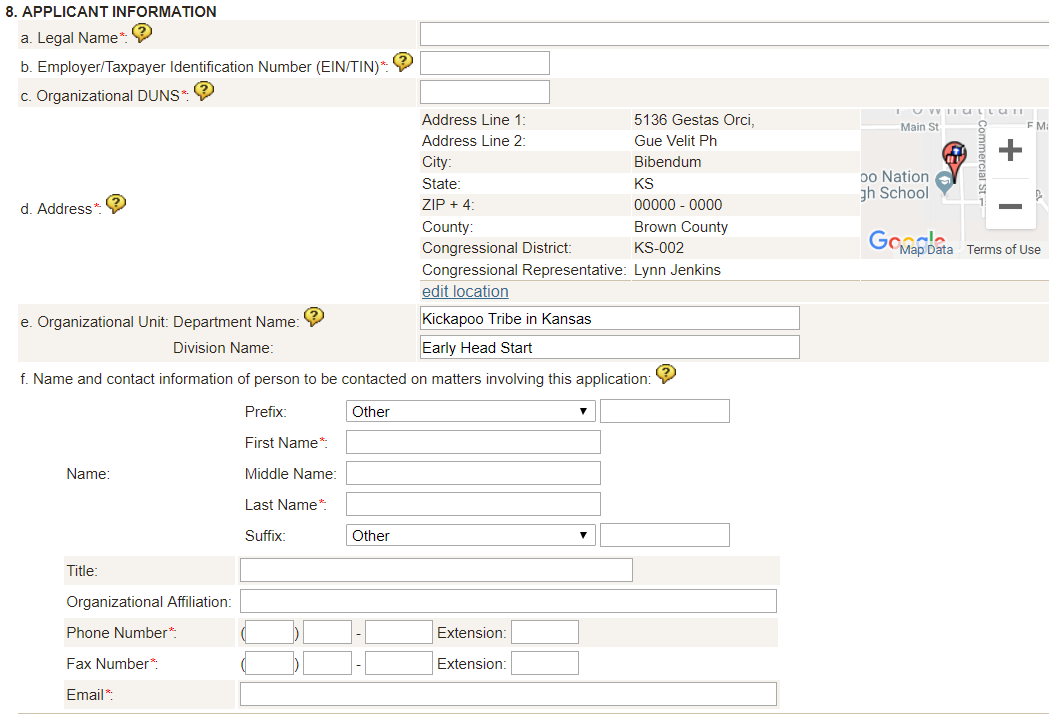
Edit Location

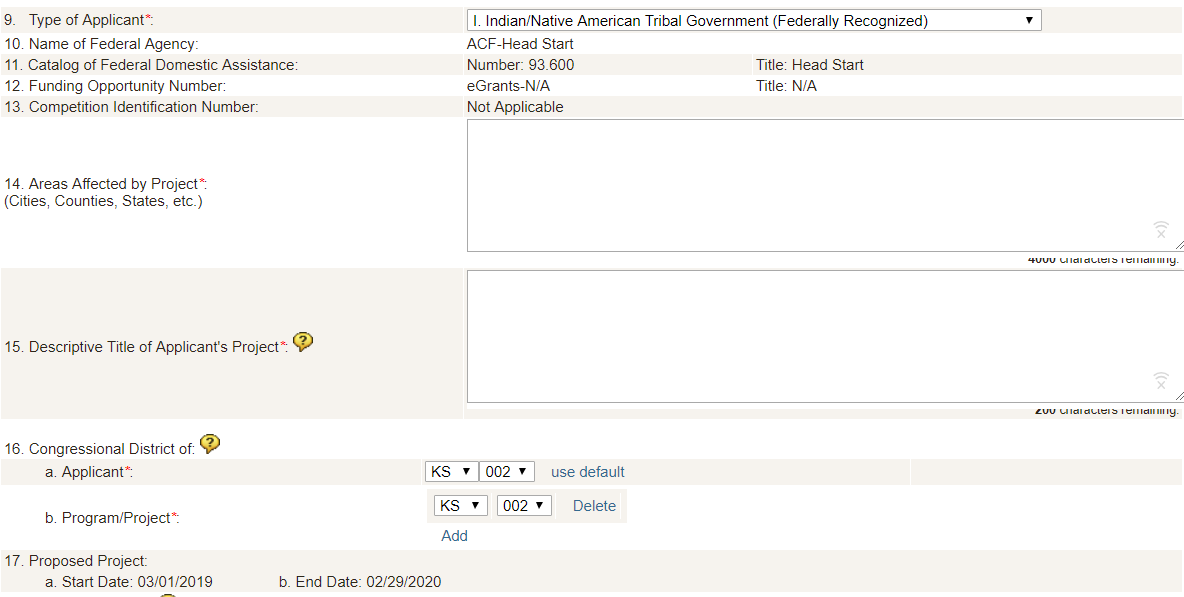
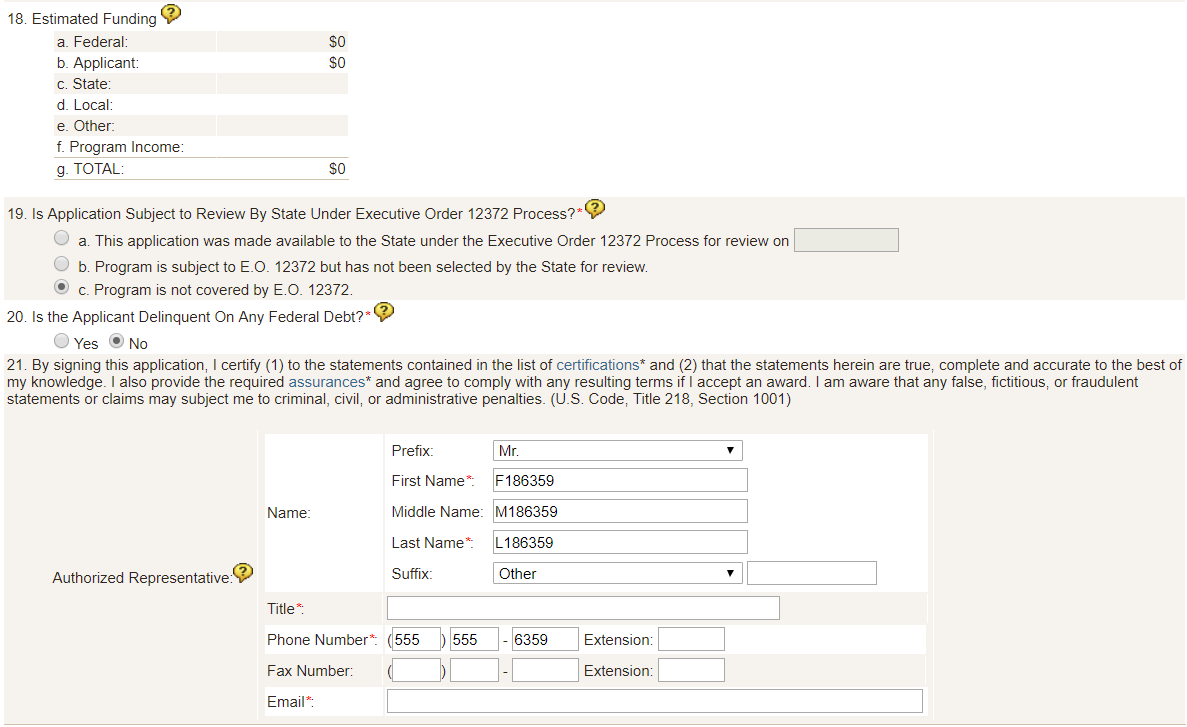
Grantee Change
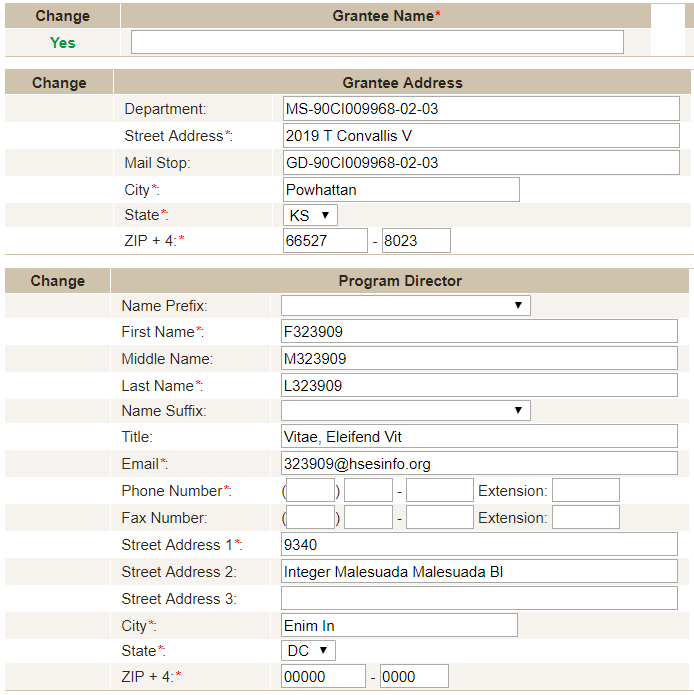
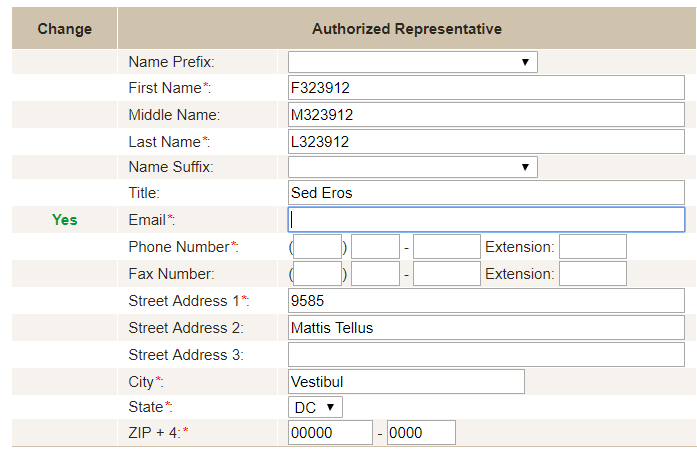
Document Upload
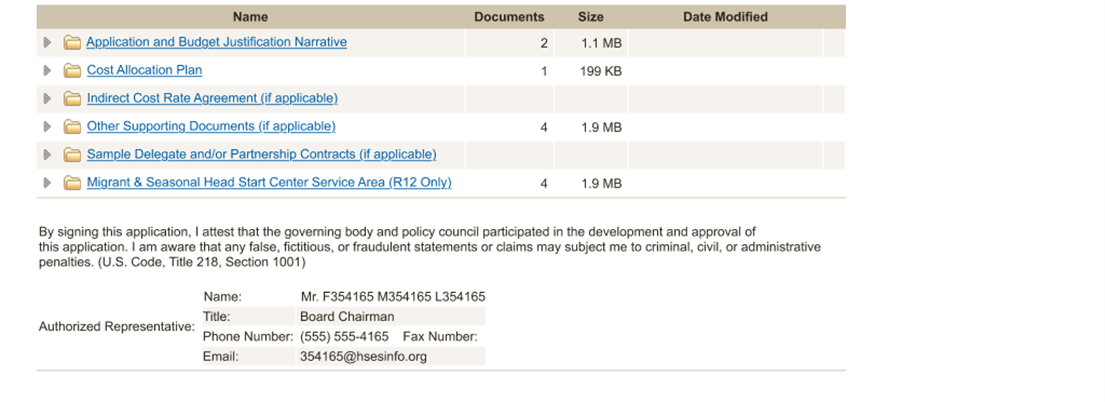
Correspondence
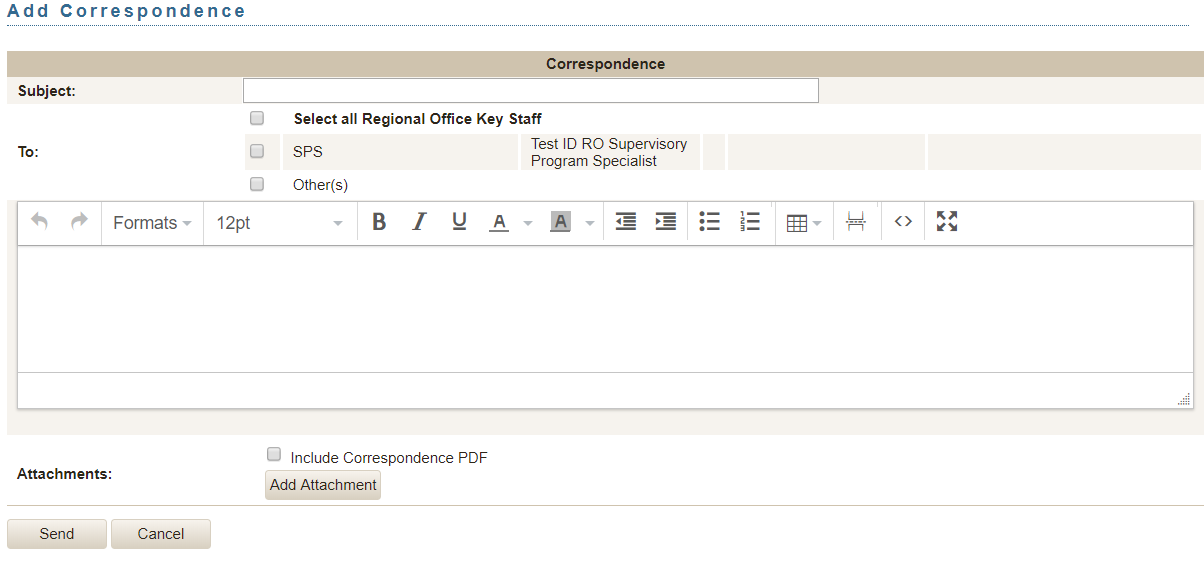
Facilities Supplement/Revision/Carryover
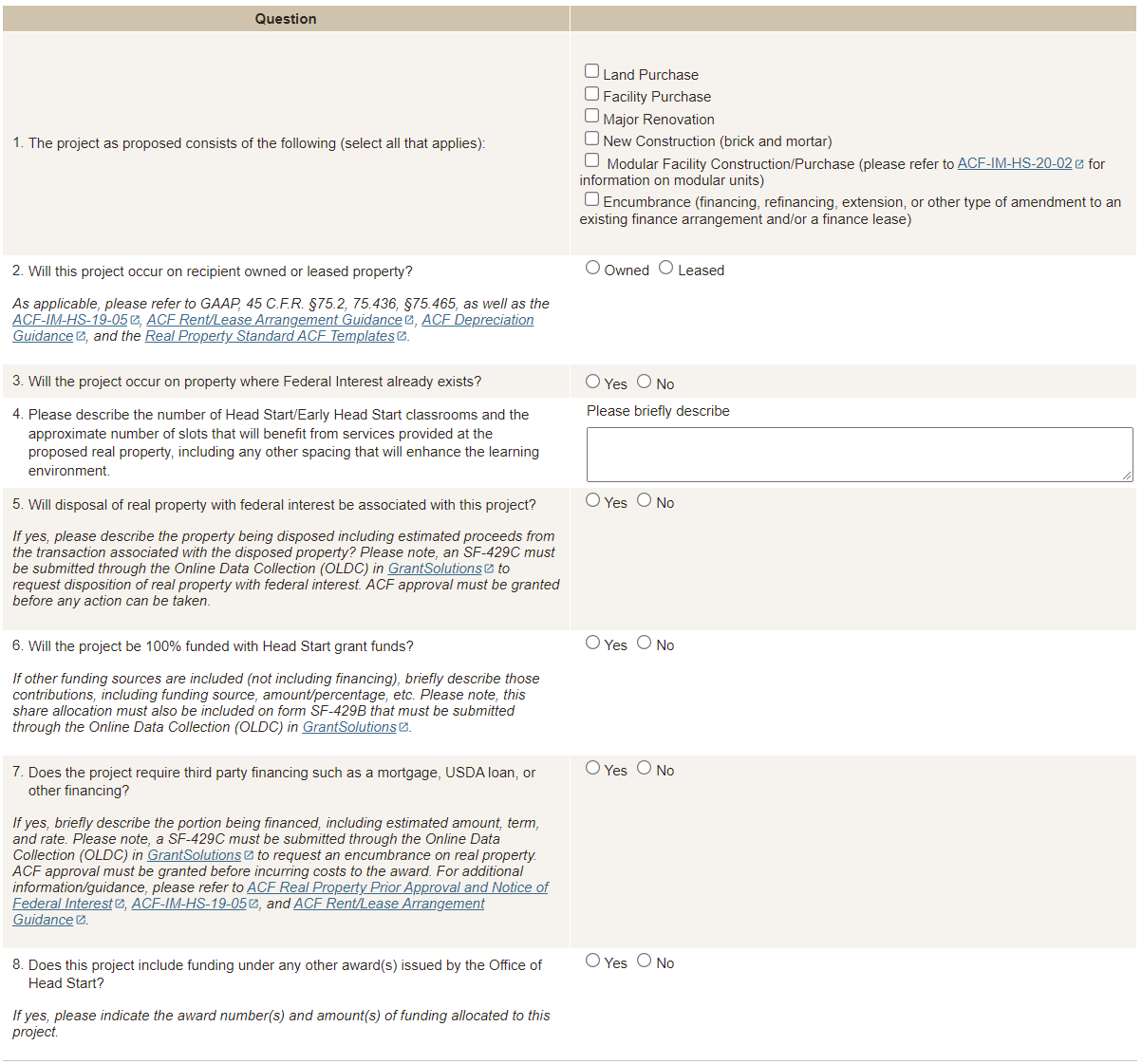
Facilities - Document Upload
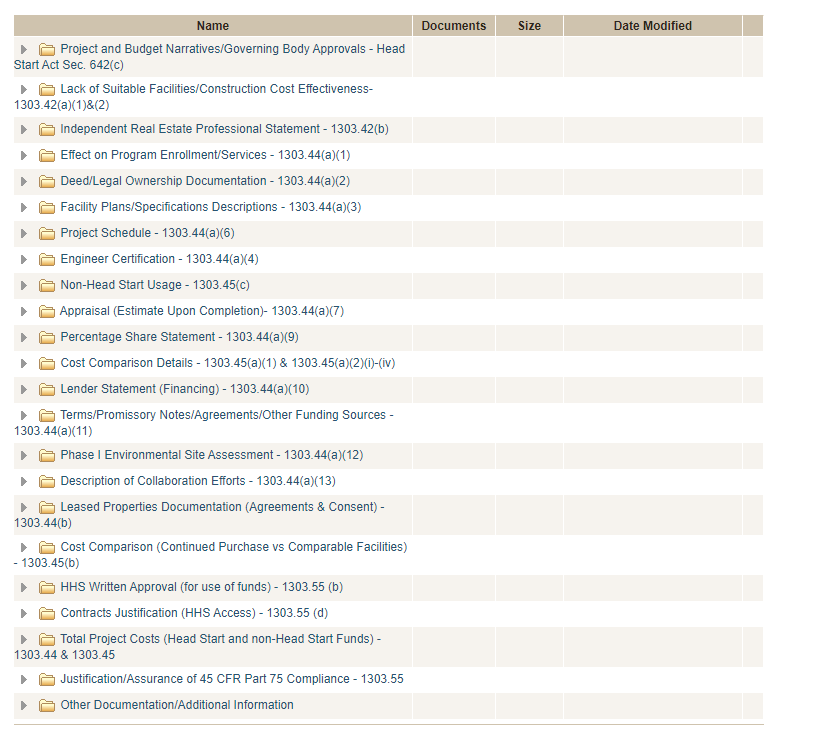
Additional questions upon submission to support the acknowledgement of documents uploaded to system
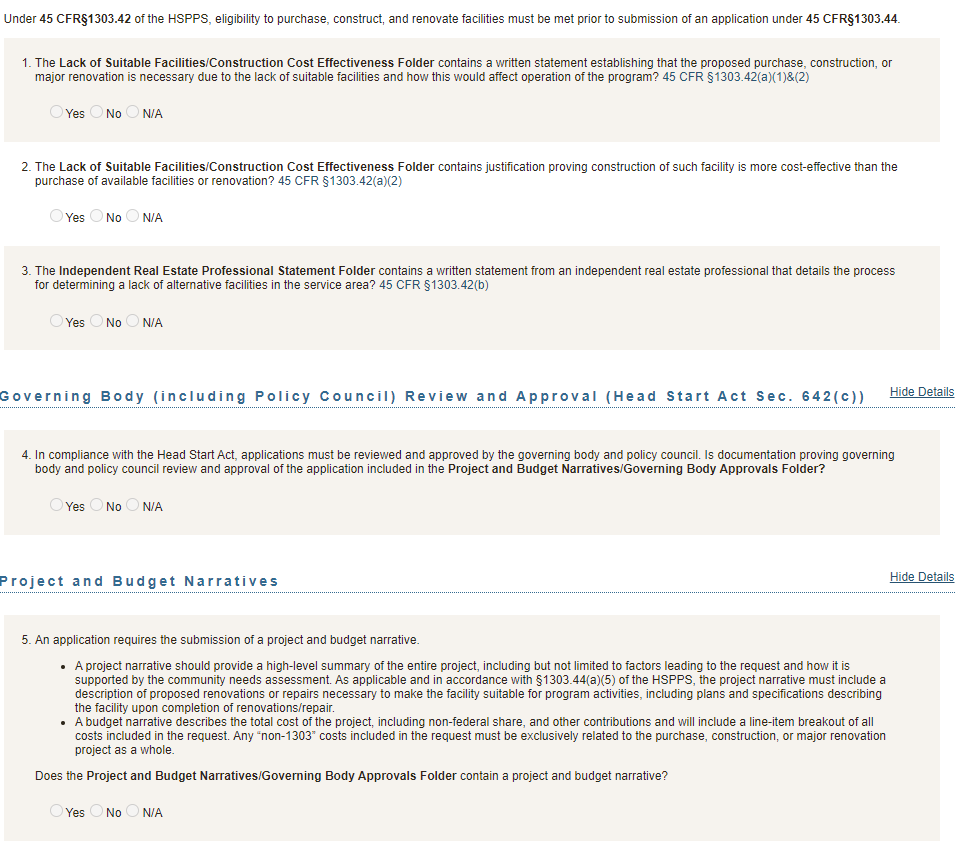
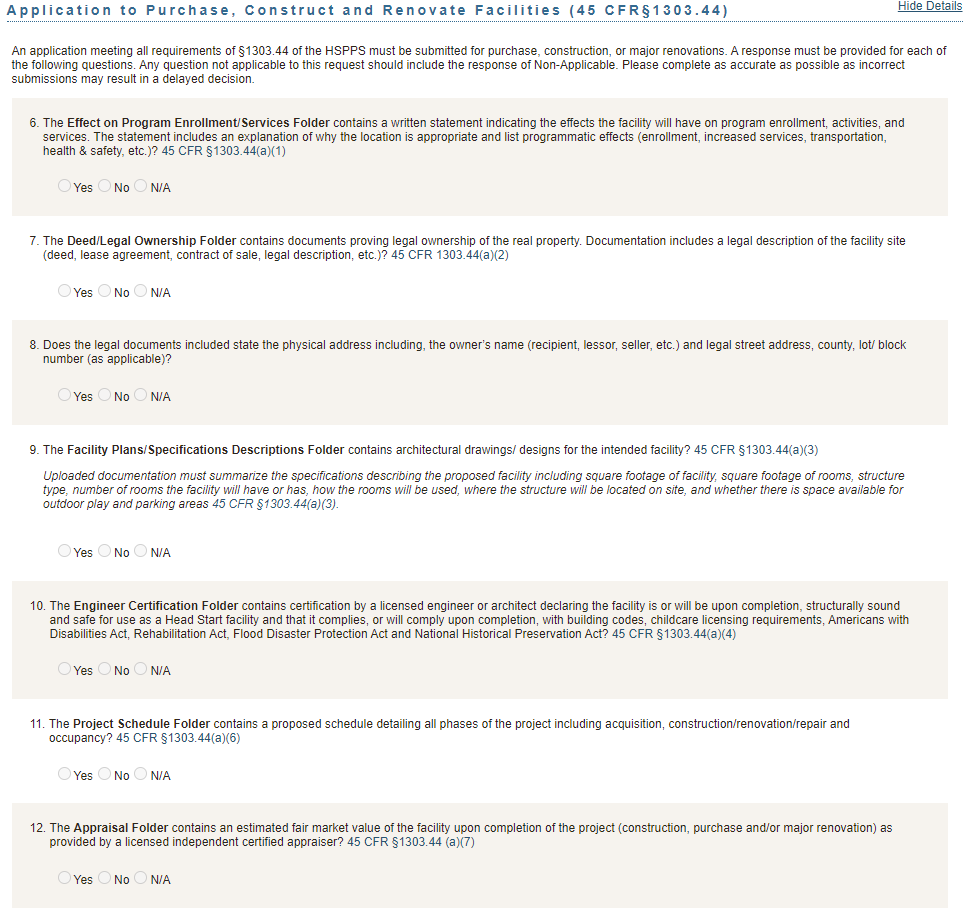
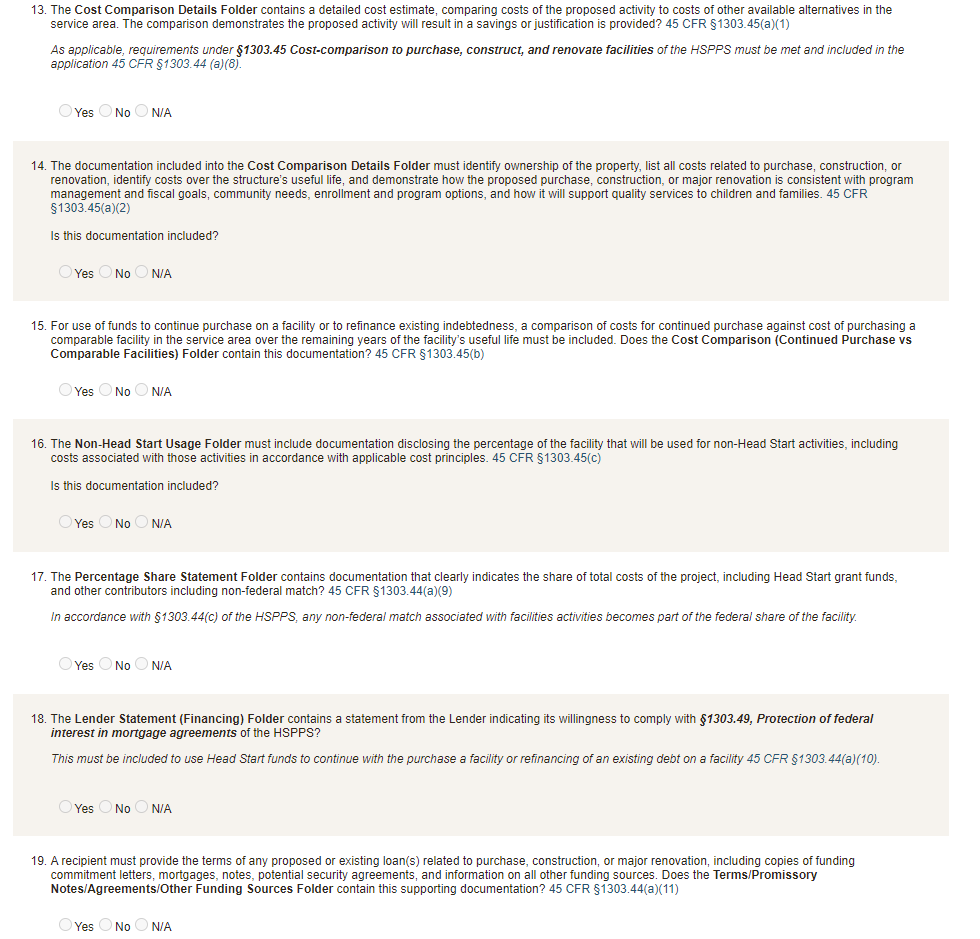
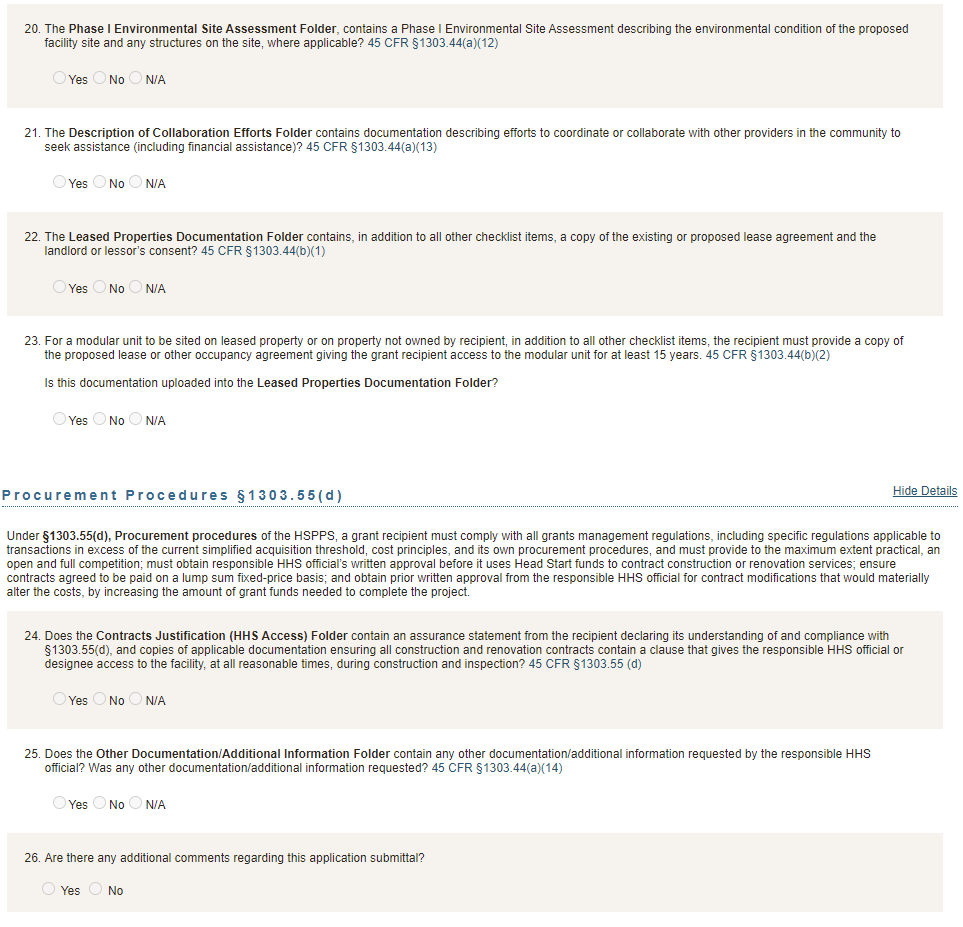


Head Start Non-Competitive Grant Application Instructions
Version 4
June 2025
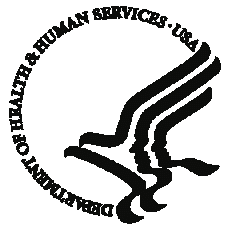
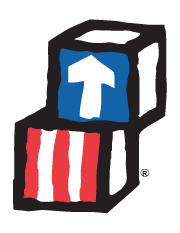
![]()
PAPERWORK
REDUCTION ACT OF 1995 (Pub. L. 104-13) STATEMENT OF PUBLIC BURDEN:
The purpose of this information collection is for eligible
entities to apply for Head Start funding. Public reporting burden for
this collection of information is estimated to average 20 hours per
respondent, including the time for reviewing instructions, gathering
and maintaining the data needed, and reviewing the collection of
information. This collection of information is required to receive
funding under the Head Start Act (42 USC 9801 et seq.). An
agency may not conduct or sponsor, and a person is not required to
respond to, a collection of information subject to the requirements
of the Paperwork Reduction Act of 1995, unless it displays a
currently valid OMB control number.
OMB Number: 0970-0207 Expiration Date: 06/30/2025
Overview of Non-Competitive Grant Application
The Office of Head Start requires recipients to submit funding applications for each year of the project period. Recipients applying for a non-competitive new grant must follow the instructions for submitting a Baseline Application for the first year of the new grant. These recipients are in the final 12 months of their current grant. Following the baseline, recipients submit a Continuation Application for the duration of the project period.
In the Baseline Application, recipients describe the program design, approach to service delivery, and supporting budget. This is an opportunity for the recipient to present their strategies for meeting certain requirements and to ensure the delivery of high-quality services, including a program design that is responsive to the needs of the children and families in the community. In the Continuation Application, recipients describe any changes and/or updates to their budget. The Office of Head Start analyzes each application to understand whether the recipient’s proposal is reasonable, allowable, and allocable.
Recipients that received a grant through the competitive process and are submitting their first grant application in HSES must complete a Baseline Application. These recipients will submit their baseline either a few months or up to a year after the start of their competitive new grant depending on the length of their initial budget period. For example, a recipient awarded a new grant, through the competitive process, with an initial budget period of 07/01/2023—03/31/2024, must submit a baseline application to receive funding for their 04/01/2024—3/31/2025 budget period.
The Office of Head Start carefully considers each recipient’s application to assure that agencies are meeting the intent of the Head Start mission, purpose, and regulations prior to issuing the Notice of Award.
Who should complete the grant application?
The completion of the grant application is a team effort. The application covers a wide range of topics and activities, and it represents a recipient’s commitment to the implementation of the program and use of federal funds.
Are there general formatting requirements?
Yes, please adhere to the following:
Each page must be double-spaced, with one-inch margins on all sides.
Use a font size of 12 for narrative.
Each page must be numbered in the lower right-hand corner.
Application Narrative and Budget Justification may not exceed 30 pages.
The application must follow the sequential order of the application instructions for the narrative. Tables, headers, and illustrations may have different formatting.
How do I receive assistance with application submission?
Please contact your Regional Office for assistance with the Application and Budget Justification Narrative instructions.
HSES training materials and a User’s Guide to support submission are found in the "Resources" section of HSES. For further technical assistance, please contact help@hsesinfo.org or 1-866-771-4737.
Instructions for Completing the Baseline Application
Submit the complete grant application package in an electronic format using the Head Start Enterprise System (HSES) at https://hses.ohs.acf.hhs.gov/hsprograms. The Grant Application section is located under the “Financials” tab. Incomplete applications will be returned for correction.
ACF-IM-HS-19-04, Accounting Simplification for Head Start and Early Head Start, announced the consolidation of the Operations CANs by program. Please note that the Program Schedule and budget projections (Budget tab) must still be completed by Head Start program operation and Early Head Start program operation within the application separately.
A complete grant application package requires completing the following application tabs in HSES:

Signed Assurances
After submitting the grant application, HSES automatically generates the following electronically signed assurances for download in the SF-424 tab:
SF-424B, Assurances – Non-Construction Programs;
Certification Regarding Lobbying;
Certification Regarding Compliance with Compensation Cap (Level II of Executive Schedule); and
Tax Certification Form.
Program Schedule
Budget
Other Funding
SF-424A
SF-424
Documents
Reminders for completing application tabs in HSES
Make relevant changes where needed (e.g., Budget, Other Funding, SF-424, Program Schedule).
Change in Scope: If proposing a Locally Designed Option, Enrollment Reduction or Conversion, indicate the application includes a “Change in Scope” request in HSES by clicking the appropriate box within the Change in Scope section on the Summary tab.
Budget: A comprehensive budget aligns with the proposed program approach and identifies allowable costs and is aggregated by object class budget category. Separate projected budgets for Head Start and Early Head Start by grant and by delegate must be completed.
Budget: Enter each partnership contract for direct services to children and families under the “Contractual” budget category tab, line “8. Other Contracts”. For each recipient or delegate budget, enter an individual financial line item in the budget for each contract over $250,000 and briefly explain the services to be provided. For any single line-item costing more than $250,000 in the “Other” budget category, please enter an individual financial line item. Applications with consolidated amounts will be returned for correction.
What documents do I upload in the Documents tab in HSES?
Upload the following documents in their respective folders of the Grant Application Documents tab in HSES. Do not upload documents completed on-screen such as the SF-424 and signed assurances.
Cost Allocation Plan
Upload a written cost allocation plan, certified in accordance with 45 CFR §75.415 that describes how shared costs, including shared staff, are allocated based on proportional benefit as required in 45 CFR §75.405. Indirect cost must be included unless the applicant has a negotiated indirect cost rate agreement or has adopted use of the 15% de minimis rate.
Indirect Cost Rate Agreement
If applicable, upload a copy of the current or proposed negotiated indirect cost rate agreement between the agency and/or delegate agencies and the respective cognizant Federal agency. If using the 15% de minimis indirect cost rate, upload a copy of the policy or other written record indicating date
upon which the rate was adopted.
Application Narrative
Sub-Section A: Service Delivery
Describe your program’s approach to meeting the need for comprehensive child development services for eligible children and families in your service area by addressing the questions below.
Service and Recruitment Area (see 1302.11(a) and 1302.13)
Identify the service and recruitment area for proposed program operations.
List your service locations. If applicable, include proposed child care partners and identify the number of children proposed to be served through partnership slots.
Needs of Children and Families (see 1302.11(b) and Special Instruction on Community Assessment)
Provide a summary of data from your community assessment that informs the program’s selection criteria and design, such as:
the estimated number of eligible children under five years of age and pregnant women by geographic location, spoken language, and other demographic variables as appropriate, including children experiencing homelessness, in foster care, and with disabilities;
data regarding the education, health, nutrition, social service, child care, parent schedules, and other service needs of the proposed children, families, and pregnant women; and
the availability of other child-development, child-care centers, and family child care programs that serve eligible children, including home visiting, publicly funded state and local preschools, and the approximate number of eligible children served.
Proposed Program Option(s) and Funded Enrollment Slots (see 1302 Subpart B and the HSPPS Compliance Table)
Specify the proposed program option(s) (i.e., center-based, home-based, family child care, and slots for services to pregnant women) and describe how your program will ensure compliance with 1302 Subpart B requirements and other applicable requirements.
Locally Designed Option. If requesting a locally-designed program option variation (LDO) waiver under 1302.24(c), explain the rationale and address the questions outlined in Locally-designed Program Option Waiver Considerations.
Discuss how your program option(s) will meet the needs of children and families in the communities served including how these options support populations identified in the community assessment and selection criteria.
Enrollment Reductions and Conversions. If proposing to reduce or convert the number of funded enrollment slots, explain the rationale and address the considerations outlined in ACF-IM-HS-22-09 and Enrollment Reduction and Conversion Considerations Appendix. Applications that do not fully address such consideration will be returned for correction and in some cases the Regional Office may require recipients to submit a separate Change in Scope Application.
Migrant and Seasonal Head Start. List centers and crops in the center service area. For each center, include dates that the center is open and closed, hours of operations (e.g. 6:00 a.m. to 5:00 p.m.), and number of infants, toddlers and/or preschoolers expected to enroll. You may upload this as a supporting document in the Migrant and Seasonal Head Start Center Service Area folder.
Eligibility, Recruitment, Selection, Enrollment, and Attendance (see 1302.13, 1302.14, 1302.15, and 1302.16)
Describe the recruitment process to ensure services will be provided to those in greatest need of program services, including specific efforts and expected challenges to actively locate, recruit, and enroll children experiencing homelessness, children in foster care, and children with disabilities.
Describe your program’s strategy to promote regular attendance including special efforts for chronically absent children.
Education and Child Development (see 1302 Subpart C)
If center-based or family child care program option is chosen, respond to item a, and c through d. If home-based program option is chosen, respond to items b through d. If locally designed program option is chosen, respond to items that apply. Programs that serve American Indian and Alaska Native (AIAN) children also respond to item e.
Center-based or family child care programs:
Identify the curriculum(a) your program will use including, if applicable, curricular enhancements and/or significant adaptations.
Home-based programs:
Identify the home-based curriculum(a) your program will use including, if applicable, curricular enhancements and/or significant adaptations
Describe group socializations to be offered.
Identify the developmental screenings and assessments your program plans to use and why, including how the program addresses screening and assessment for children who are dual language learners.
Describe opportunities offered to parents and family members to be engaged in their child’s education such as participation in screenings and assessment and providing feedback on the selected curriculum and instructional materials.
For programs serving AIAN children, and where applicable, describe efforts for Tribal language preservation, revitalization, restoration, or maintenance.
Health (see 1302 Subpart D)
Describe how your program will, in partnership with parents, meet the oral health, nutritional, mental health, social and emotional well-being, health status and care needs of children and support each child’s growth and school readiness:
Include how your program will ensure up-to-date child health status, ongoing care, and timely follow-up care.
For mental health and social and emotional well-being, describe how a program will provide mental health consultation services in partnership with staff and families.
Describe your program’s timeline for conducting screenings of the health and safety environments of each center and/or family childcare home where services are provided. (https://eclkc.ohs.acf.hhs.gov/sites/default/files/pdf/chs-certification-fillableform.pdf) Health and Safety screenings must be completed within 45 days of:
the start of the school year,
children receiving services in a new environment, and/or
start of project period when the project period begins during the program or school year
Family and Community Engagement (see 1302 Subpart E)
Describe key program strategies for building trusting and respectful relationships with families and for providing program environments and services that are welcoming and culturally and linguistically responsive to families, including those specific to fathers.
Describe engagement activities to support parent-child relationships, child development, family literacy, and language development.
Describe how your program has selected and is implementing a research-based parenting curriculum. Describe how your program engages parents in a research-based parenting curriculum.
Describe key program strategies for family partnership services, including:
Procedures for conducting the family assessment and family partnership process and aligning activities to the Parent, Family, and Community Engagement Framework outcomes; and
Tracking progress toward individual family goals and needs.
Provide a few examples of community partnerships that facilitate access to services or resources in the community that are responsive to family partnership goals and children’s needs. Identify any challenges to necessary partnerships and how the program plans to address those challenges.
Services for Children with Disabilities (1302 Subpart F)
Describe how your program will ensure the full participation in program services and activities for enrolled children with disabilities, including but not limited to those who are eligible for services under IDEA and those who already have an IFSP or IEP.
Describe how your program will ensure the individualized needs of children with disabilities are met, including how the program will collaborate with and help parents in the process and how the program will coordinate and collaborate with the local agency responsible for implementing IDEA.
Transition (see 1302 Subpart G)
Describe strategies and practices to support successful transitions in:
Transitions to and from Early Head Start;
Transitions from Head Start to kindergarten; and
Transitions between programs.
Services to Enrolled Pregnant Women (see 1302 Subpart H)
Describe how your program facilitates access to a source of ongoing care for enrolled pregnant women that do not have existing access to such care.
Describe your program’s strategy to provide prenatal and postpartum information, education, and services such as those that address fetal development, nutrition, risks of alcohol and drugs, postpartum recovery, and infant care and safe sleep practices.
Describe how your program’s family partnership services include a focus on factors that influence prenatal and postpartum maternal and infant health, includes other relevant family members, and support the transition process.
Transportation (see 1303 Subpart F)
Describe the level of need for child transportation services.
Describe how your program will either directly meet transportation needs or assist families in accessing other transportation so that children can attend the program.
Sub-Section B: Governance, Organizational, and Management Structures
Describe the governance, organizational, and management structures that support quality
services and maintain accountability, efficiency, and leadership within your program by addressing the questions below.
Governance (see 45 CFR Part 1301 and Section 642(c)-(d) in the Act)
Structure
Identify the member (i) with expertise in fiscal management or accounting, (ii) with expertise in early childhood education and development, and (iii) the licensed attorney familiar with program governance issues in the governing body/tribal council.
Describe how your program ensures additional members on the governing body reflect the community, including parents, and representation from other key programmatic areas.
Describe the makeup of the policy council or if applicable, the policy committee. Include how each program option is represented.
Processes
Governing Body
Describe how the governing body receives key program information as outlined in 1301.2(b)(2) to inform their ongoing responsibilities including how decisions submitted by the policy council are incorporated into the decision-making process. Describe other key processes to ensure the governing body maintains effective ongoing oversight of program operations and accountability for federal funds.
If applicable, describe and explain the responsibilities delegated to any advisory committee related to program governance and improvement of the Head Start program. Include how the governing body maintains its legal and fiscal responsibility in the process.
Policy Council and Policy Committee
Describe how the policy council, and if applicable, the policy committee, receives and shares key program information as outlined 1301.3(c)(2) to inform their ongoing responsibilities.
Parent Committees
Describe how the parent committees communicate with staff to inform program policies, activities, and services to ensure they meet the needs of children and families.
Describe the process for communication with the policy council and policy committees.
Human Resources Management (see 1302 Subpart I)
Provide an organizational chart identifying the management and staffing structure including the Executive Director, the Program Directors, managers, and other key staff. Include assigned areas of responsibility and lines of communication. You may upload this as a supporting document.
Describe your program’s approach to establishing pay scales, determining compensation rates, and wage comparability within service area.
Describe systems developed to ensure criminal background checks occur prior to hire for all staff, consultants, and contractors in the program.
Describe orientations provided to new staff, consultants, and volunteers.
Describe key features of your program’s approach to staff training and professional development. Describe your program’s approach to implementing a research-based coordinated coaching strategy, including the approach to the delivery of intensive coaching for identified staff.
Program Management and Quality Improvement (see 1302 Subpart J)
Describe key features of your program’s systems for ongoing oversight, correction, and assessment of progress towards your program’s identified goals. Include approaches that promote effective teaching and health and safety practices.
Describe key features of your program’s management process and system to ensure continuous program improvement that relate to effectively using data and ongoing supervision to support individual staff professional development and promote staff retention.
Describe how the management system ensures budget and staffing patterns that promote continuity of care, allow sufficient time for staff participation in training and professional development, and allow for provision of the full range of services.
If applicable, describe any internal controls findings/issues identified through ongoing monitoring, self-assessment, or recent audits and describe plans to address such findings/issues.
Budget Justification
Separate projected budgets must be completed for both Head Start and Early Head Start program operations and Head Start and Early Head Start training and technical assistance by grant and by delegate.
Upload a detailed narrative to explain the costs by object class budget category identified within the SF-424A Section B-6. The total amount of funds detailed in the budget narrative must equal the total amount requested in the SF-424A.
Program Operations
Explain significant personnel and fringe adjustments for this budget period for lines a and b on the SF-424A. Please be sure to identify salaries that are cost allocated amongst other programs, federal and non-federal.
For each lines c through h on the SF-424A, ensure the narrative aligns with the amounts requested for direct and, if applicable, indirect costs. If applicable, identify cost allocated expenses, federal and non-federal.
If applicable, describe the planned use of cost-of-living adjustment (COLA) funds based on the related Program Instruction.
Identify each source of non-federal match, including the estimated amount per source and the valuation methodology. Explain how your program determined that proposed non-federal match is allowable per 45 CFR §75.306, 2 CFR § 200.306, and Section 1303.4.
Enrollment Reductions and Conversions. If requesting an enrollment reduction or conversion, explain the rationale and address the budget considerations outlined in ACF-IM-HS-22-09 and Enrollment Reduction and Conversion Considerations Appendix. Applications that do not fully address such consideration will be returned for correction and in some cases the Regional Office may require recipients to submit a separate Change in Scope Application.
If requesting funds for equipment as defined in 2 CFR § 200.439, identify each item individually and describe the procurement procedures to be followed for the purchase of such equipment. See equipment definition at 2 CFR § 200.1.
Training and Technical Assistance
Training and technical assistance funds are awarded separately by program. Describe the use of these funds, by object class budget category identified within the SF-424A Section B-6, to support the recipient’s training and technical assistance activities.
Sample Delegate and/or Partnership Contracts
If applicable, upload sample delegate and/or partnership contracts.
Other Supporting Documents
If applicable, upload other supporting documents as needed such as organizational charts, program calendars, etc.
Instructions for Completing the Continuation Application
Submit the complete grant application package in an electronic format using the Head Start Enterprise System (HSES) at https://hses.ohs.acf.hhs.gov/hsprograms. The Grant Application section is located under the “Financials” tab. Incomplete applications will be returned for correction.
ACF-IM-HS-19-04, Accounting Simplification for Head Start and Early Head Start, announced the consolidation of the Operations CANs by program. Please note that the Program Schedule and budget projections (Budget tab) must still be completed by Head Start program operation and Early Head Start program operation within the application separately.
A complete grant application package requires completing the following application tabs in HSES:

Signed Assurances
After submitting the grant application, HSES automatically generates the following electronically signed assurances for download in the SF-424 tab:
SF-424B, Assurances – Non-Construction Programs;
Certification Regarding Lobbying;
Certification Regarding Compliance with Compensation Cap (Level II of Executive Schedule); and
Tax Certification Form.
Program Schedule
Budget
Other Funding
SF-424A
SF-424
Documents
Reminders for completing application tabs in HSES
Make relevant changes where needed (e.g., Budget, Other Funding, SF-424, Program Schedule).
Change in Scope: If proposing a Locally Designed Option, Enrollment Reduction or Conversion, indicate the application includes a “Change in Scope” request in HSES by clicking the appropriate box within the Change in Scope section on the Summary tab.
Budget: A comprehensive budget aligns with the proposed program approach and identifies allowable costs and is aggregated by object class budget category. Separate projected budgets for Head Start and Early Head Start by grant and by delegate must be completed.
Budget: Enter each partnership contract for direct services to children and families under the “Contractual” budget category tab, line “8. Other Contracts”. For each recipient or delegate budget, enter an individual financial line item in the budget for each contract over $250,000 and briefly explain the services to be provided. For any single line-item costing more than $250,000 in the “Other” budget category, please enter an individual financial line item. Applications with consolidated amounts will be returned for correction.
What documents do I upload in the Documents tab in HSES?
Upload the following documents in their respective folders of the Grant Application Documents tab in HSES. Do not upload documents completed on-screen such as the SF-424 and signed assurances.
Cost Allocation Plan
Upload a written cost allocation plan, certified in accordance with 45 CFR §75.415 that describes how shared costs, including shared staff, are allocated based on proportional benefit as required in 45 CFR §75.405. Indirect cost must be included unless the applicant has a negotiated indirect cost rate agreement or has adopted use of the 15% de minimis rate.
Indirect Cost Rate Agreement
If applicable, upload a copy of the current or proposed negotiated indirect cost rate agreement between the agency and/or delegate agencies and the respective cognizant Federal agency. If using the 15% de minimis indirect cost rate, upload a copy of the policy or other written record indicating date upon which the rate was adopted.
Application Narrative
Locally Designed Option. If requesting a locally-designed program option variation (LDO) waiver under 1302.24(c), explain the rationale and address the questions outlined in Locally-designed Program Option Waiver Considerations.
Enrollment Reductions and Conversions. If proposing to reduce or convert the number of funded enrollment slots, explain the rationale and address the considerations outlined in ACF-IM-HS-22-09 and Enrollment Reduction and Conversion Considerations Appendix. Applications that do not fully address such consideration will be returned for correction and in some cases the Regional Office may require recipients to submit a separate Change in Scope Application.
Migrant and Seasonal Head Start. List centers and crops in the center service area. For each center, include dates that the center is open and closed, hours of operations (e.g. 6:00 a.m. to 5:00 p.m.), and number of infants, toddlers and/or preschoolers expected to enroll. You may upload this as a supporting document in the Migrant and Seasonal Head Start Center Service Area folder.
Budget Justification
Separate projected budgets must be completed for both Head Start and Early Head Start program operations and Head Start and Early Head Start training and technical assistance by grant and by delegate.
Upload a detailed narrative to explain the costs by object class budget category identified within the SF-424A Section B-6. The total amount of funds detailed in the budget narrative must equal the total amount requested in the SF-424A.
Program Operations
Explain significant personnel and fringe adjustments for this budget period for lines a and b on the SF-424A. Please be sure to identify salaries that are cost allocated amongst other programs, federal and non-federal.
For each lines c through h on the SF-424A, ensure the narrative aligns with the amounts requested for direct and, if applicable, indirect costs. If applicable, identify cost allocated expenses, federal and non-federal.
If applicable, describe the planned use of cost-of-living adjustment (COLA) funds based on the related Program Instruction.
Identify each source of non-federal match, including the estimated amount per source and the valuation methodology. Explain how your program determined that proposed non-federal match is allowable per 45 CFR §75.306, 2 CFR § 200.306, and Section 1303.4.
Enrollment Reductions and Conversions. If requesting an enrollment reduction or conversion, explain the rationale and address the budget considerations outlined in ACF-IM-HS-22-09 and Enrollment Reduction and Conversion Considerations Appendix. Applications that do not fully address such consideration will be returned for correction and in some cases the Regional Office may require recipients to submit a separate Change in Scope Application.
If requesting funds for equipment as defined in 2 CFR § 200.439, identify each item individually and describe the procurement procedures to be followed for the purchase of such equipment. See equipment definition at 2 CFR § 200.1.
Training and Technical Assistance
Training and technical assistance funds are awarded separately by program. Describe the use of these funds, by object class budget category identified within the SF-424A Section B-6, to support the recipient’s training and technical assistance activities.
Sample Delegate and/or Partnership Contracts
If applicable, upload sample delegate and/or partnership contracts.
Other Supporting Documents
If applicable, upload other supporting documents as needed.
| File Type | application/vnd.openxmlformats-officedocument.wordprocessingml.document |
| Author | Hodge, Priscilla (ACF) |
| File Modified | 0000-00-00 |
| File Created | 2025-07-17 |
© 2025 OMB.report | Privacy Policy